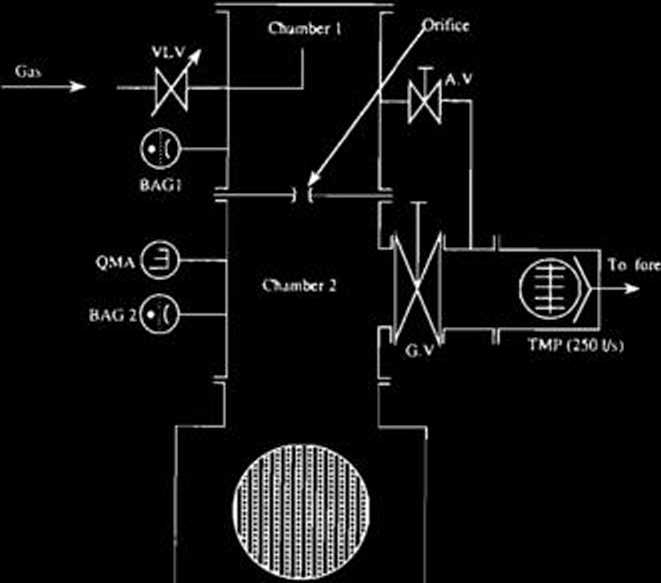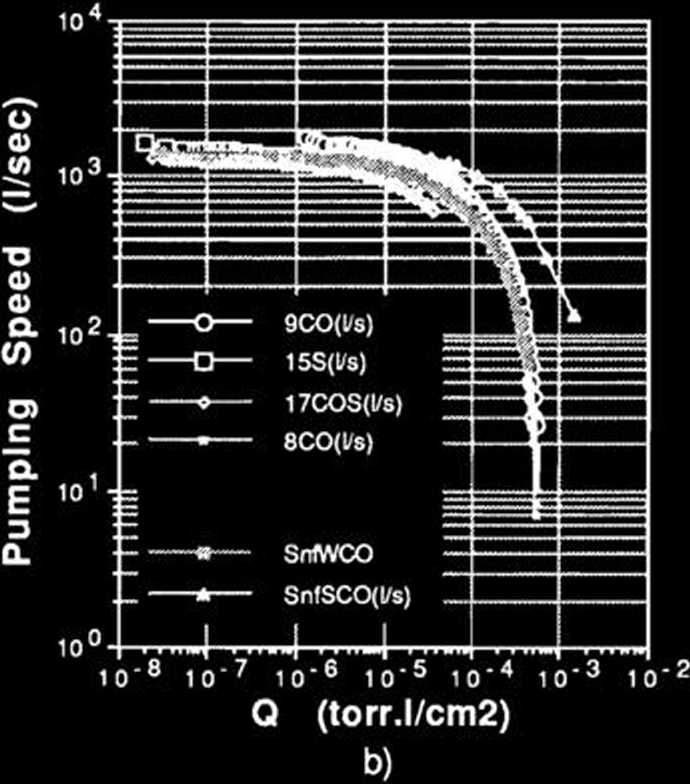372596181
174
RIKEN Accel. Próg. Rep. 24 (1990)
V-2-20. Performance Test of Lumped NEG Pump
S.R. In,1 T. Maruyama,2 S Yokouchi, and S.H. Be
In the vacuum system of SPring-8, synchrotron radiation produced in bending magnets is mostly intercepted by crotches and absorbers. To protect other vacuum components from severe inrush of the photo-desorbed particles from the crotches and absorbers, a proper pumping system of sufficient pumping speed and capacity must be prepared. A Lumped NEG Pump (LNP) was manufactured and tested to examine such reąuirement.
Słructure of LNP A proto-type LNPn consists of

LNP
LNP lumped Nc$ P%/np TMP Turbo MotoCutJr Pump OMA Oujdrupok AnaJyicr DACil.i B-iyjrJ Alpen Nade Gjuge A V Mi/iutl Arifle V*l\«
GV M»w|(uifV VLV Vmjbte Uak VłIvc
Fig. 1. Schematic diagram of the experimentaJ setup for the LNP.
14 St 707 non-evaporable getter (NEG) wafer mod-ules installed concentrically in a cylindrical housing madę of Al-alloy. The inner virtual surface madę by 14 wafer modules forms a strong adsorbing cylindrical channel of which diameter and length are all 250 mm. The diameter of the pumping port is 200 mm, and the total weight of the LNP is about 45 kgf.
Performance test of LNP Figurę 1 shows a schematic diagram of the experimental setup. Figurę 2 indicates the pumping speeds of the LNP for H2, CO, N2 and C02. CO is morę reactive with the NEG materiał and, conseąuently, has a higher sticking coefficient than H2. However the pumping

Q (torr.l/cm2)
a)


Q (torr.l/cm2)
Fig. 2. Pumping speeds of the LNP for H2, CO, N2, and C02 as a function of the sorption amount of each gas.

Fig. 3. Comparison of measured pumping speeds of the LNP for a) H2 and b) CO with calculated pumping speeds using the data of 1 wafer module experiment.
On leave from KAERI, Dajeon, Korea.
♦ 1 Osaka Yacuum Ltd.
Wyszukiwarka
Podobne podstrony:
174 RIKEN Accel. Próg. Rep. 24 (1990)V-2-20. Performance Test of Lumped NEG PumpS.R. In,1 T. Maruyam
92 RIKEN Accel. Próg. Rep. 24 (1990)111-5. Instrumentation1. Design of a Microbeamline for a Compact
102 RIKEN Accel Próg. Rep. 24 (1990)111-5-8. Performance of Isotopic Separation in RIPS T.Nakamura,
110 RIKEN Accel. Próg. Rep. 24 (1990)111-5-14. Test for Dispersive-Mode Beam Transportto the SMART
116 RIKEN Accel. Próg. Rep. 24 (1990)111-5-19. Responses of Large Position-Sensitive Detectorsto Hea
121 RIKEN Accel. Próg. Rep. 24 (1990)IM-5-23. A Test for SMART Neutron Detectors H. Orihara, K. Hata
158 RIKEN Accel. Próg. Rep. 24 (1990)V-2-ll. Bump Magnet of SPring-8 H. Miyade, H. Takebe, and S. Mo
199 RIKEN Accel. Próg. Rep. 24 (1990)V-2-34. Bending Fabrication of a Vaccum ChamberT. Nishodono, T.
11 RIKEN Accel. Próg. Rep. 24 (1990)111-1-2. Three a Disintegration of 12C in the Field of208Pb Nucl
63 RIKEN Accel. Próg. Rep. 24 (1990)111-2-28. Development of Nuclear Track Microfilters N. Nakanishi
72 RIKEN Accel. Próg. Rep. 24 (1990)111*3-8. Dry Separation of Radioactive Nuclides from a Gold Targ
80 RIKEN Accel. Próg. Rep. 24 (1990)111-3-16. Development of an lon Beam Sputtering Method toPrepare
121 RIKEN Accel. Próg. Rep. 24 (1990)IM-5-23. A Test for SMART Neutron Detectors H. Orihara, K. Hata
więcej podobnych podstron